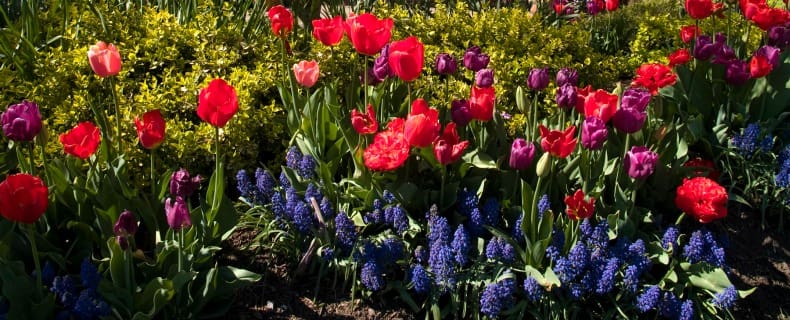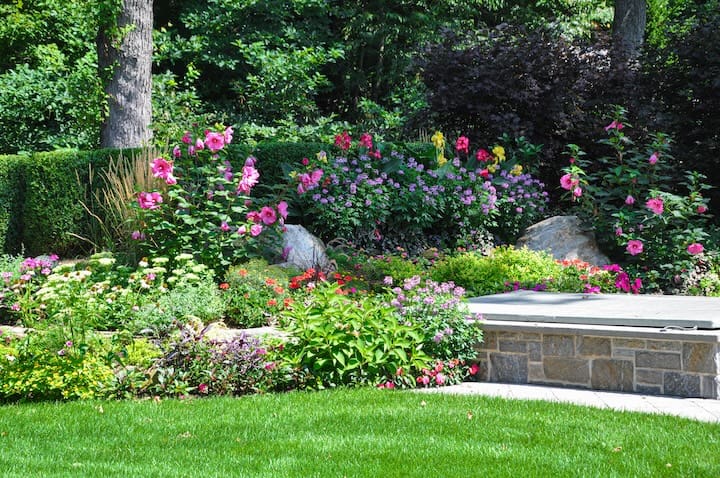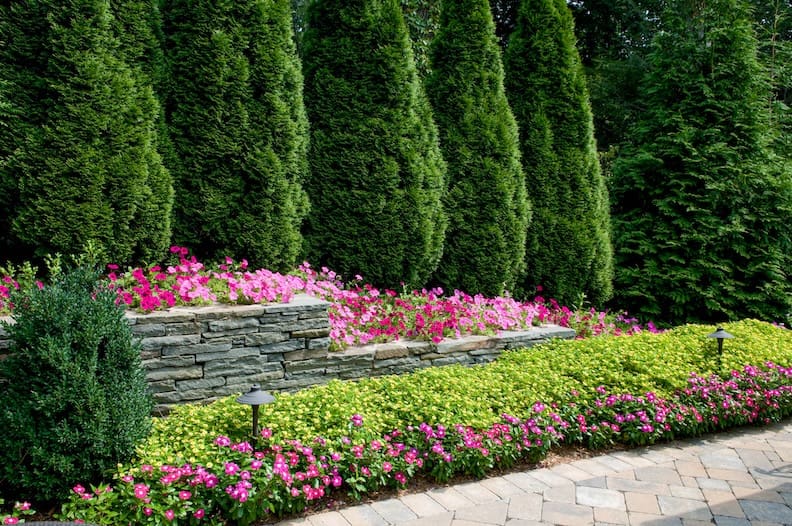Unlock Year-Round Beauty with the Help of a Seasonal Planting Guide
A seasonal planting guide is an invaluable tool for maintaining a beautiful landscape year-round. Providing specific recommendations for each season, it ensures that your garden remains vibrant and visually appealing from season to season. Whether you’re selecting colorful annuals for summer, hearty perennials for autumn, or evergreen shrubs for winter interest, a well-curated guide ensures that your garden thrives any time of year.
The experienced team at Borst Landscape & Design can help cultivate a landscape for your Bergen County home that delights the senses and adds charm to your outdoor space, no matter the time of year. Give us a call at (201) 785-9400 or contact us through our website to schedule a free consultation to get started on your dream garden today!

Planting Zones
The USDA categorizes the United States into different hardiness planting zones, which are determined by various factors, including climate, average temperatures, sunlight, precipitation, and geographical features like proximity to water bodies and elevation. The latest USDA plant hardiness map takes all these factors into account, including the urban heat effect.
In Bergen County, the Northwest corner falls within Zone 6a, while the Eastern part falls in Zone 6b. Planting and growing seasons typically extend from mid-March, after the last frost, through mid-November in these zones. When choosing plants for your landscape or garden, consult the seasonal planting guide for Zone 6 to ensure optimal growth and adaptation to local conditions.
How Are Annuals and Perennials Different?
Annuals
For many gardeners, annuals are a mainstay for any garden. Early-blooming spring annuals are a quick way to fill empty spots in flower beds, container gardens, and decorative pots.
A mix of annual plants can offer a stunning array of vibrant colors in your landscape during spring, summer, and fall. Although you will have to replant them each season, annuals will create a beautiful landscape when they bloom.
Perennials
Perennials are plants and flowers that come back year after year. Since you don’t have to replant them, they are perfect for garden beds, as accents to shrubs and trees, combined with annuals and bulbs, and in containers and window boxes.
Perennials often increase in size each year so that they can be divided and added to other seasonal plants and landscape areas.
Planting Guide for Each Season
Spring Season (March – May)
In early spring, everything in your landscape begins to grow at a faster rate. Spring sunshine and warm weather bring new buds to flowers and new leaves to plants and trees.
Spring is a major growth season and the perfect time to fill your garden beds with bulbs, annuals, and perennials that will bloom during the summer, fall, and even winter seasons.
Here are some seasonal planting guide tips for the spring season.
Annuals
- African Marigolds—African marigolds produce 3-inch puffball blooms in orange, yellow, and cream. Regular varieties grow up to three feet tall, but dwarf varieties only grow to one foot tall. The mounded dark green foliage beneath the blooms is always clean, fresh, and tidy.
- Begonias—Begonias are easy-to-grow spring seasonal plants that do well in a variety of landscape conditions. To keep the blooms colorful, give begonias light shade, rich, well-drained soil, ample water, and plenty of fertilizer.
- Bush Morning Glory—Bush Morning Glory is the perfect plant for flower beds and window boxes. It produces trumpet-shaped flowers in jewel-tone shades of blue, pink, and white. It grows close to the ground, about two feet tall, so it’s a good border plant.
- Pansy—Pansies are one of the best annuals to plant in spring for early-season containers and window boxes. They come in a variety of vibrant colors that will add instant, eye-catching appeal to your landscape.
Cool-Season Annuals
Cool-season annuals, such as begonias, primroses, pansies, and calendula, grow best in the mild temperatures and cool soils of spring and fall.
When the weather turns hot, cool-season annuals set seed and deteriorate, but most will survive fairly heavy frost. In Bergen County, cool-season annuals should be planted in early spring.
To develop vigorous blooms, roots, and foliage must develop during cool weather.
Warm-Season Annuals
Warm-season annuals, like impatiens, marigolds, and zinnias, grow and flower best in the warm months of late spring, summer, and early fall.
If warm-season annuals are planted too early in the spring, they can die in a late frost. In cold-winter climates like Northern New Jersey, warm-season annuals should be planted after the danger of all frost has passed.
Summer-Flowering Bulbs
Summer-blooming bulbs, like callas, dahlias, gladiolas, liatris, and lilies, should be planted in early spring for vibrant summer flowers.
All of these summer-blooming bulbs will provide a brilliant array of colors in your landscape, including vivid shades of yellow, orange, red, pink, lavender, and purple.
Most of these flower varieties grow from 1 foot to 7 feet tall, so they provide wonderful height against shorter plants.
Summer-Blooming Vines
For a great splash of summer color in your Bergen County landscape, plant summer-blooming vines against retainer walls, fences and trellises.
Trumpet vines will add a burst of vivid red, orange, or yellow trumpet-shaped flowers that attract hummingbirds.
Hydrangea vines will provide a softer look with flowers that range from white to pink.
For more options for summer-blooming vines, check your seasonal planting guide for planting zone 6 in Bergen County.
Bare-Root and Container Roses
In Northern NJ, bare-root roses should be planted in the spring, as soon as it’s warm enough to work the soil.
Before planting, soak the roots in a bucket of water for 8 to 12 hours to rehydrate them, then immerse the entire plant to rehydrate the canes.
After soaking, trim off any damaged or diseased roots before planting. Potted roses are the easiest to plant because you have a plant that is already growing. Potted roses can be planted in the spring right after you buy them.
Needle-Leafed Evergreens
If you want to add needle-leafed evergreens to your landscape, plant them in late spring.
Needle-leafed evergreens, like pines, firs, cypress and spruce, will add wonderful texture to your landscape, especially during fall and winter seasons when your landscape can look a little barren.
Talk to your landscape professional about seasonal planting guide tips for adding needle-leafed evergreen to your yard.
Summer Season (June – August)
Fall-Blooming Perennials
For color in the fall, plant fall-blooming perennials, such as asters, coneflowers, chrysanthemums, and sedums, in the summer.
Fall-blooming perennials offer brilliant jewel-tone colors like gold, orange, red, and deep purple. They make great plants for garden beds, containers, walkways, driveways, and patio borders.
Ornamental Grasses
If you’re looking for exotic textures and beautiful green foliage, ornamental grasses can add them to your landscape year-round.
Summer is a good time to plant most varieties, so they will provide fall and winter greenery when many colorful annuals and perennials die back.
Baby bamboo, cattails, golden pheasant’s tail, and mondo grass are great for Bergen County landscapes.
Ground Covers
Groundcovers are dependable, strong plants that carpet the ground with minimal fuss. They provide quick-fix solutions for many landscape problems.
Groundcovers come with interesting textures and flowers that thrive in shade or sun. Brass buttons have feathery, bronze foliage and button-like yellow-green blooms in early summer.
Hens-and-chicks, an old-fashioned favorite, grows well in tight spaces and sunny areas, and it’s easy to grow with little maintenance.
Drought-Tolerant Plants
Although Northern New Jersey gets ample rainfall most of the year, many homeowners are interested in native and drought-tolerant plants for their landscapes.
Butterfly milkweed, crimson-eyed rose mallow, lance-leaved coreopsis, New England aster, and New York ironweed are all drought-tolerant plant varieties that thrive in Bergen County landscapes.
The seasonal planting guide for Zone 6 lists these native varieties, as well as others, for the area.
Fall Season (September – November)
Fall Perennials
The seasonal planting guide for Northern NJ offers a wide variety of colorful plants that bloom in the fall and thrive in Bergen County landscapes.
Asters are sun-loving fall flowers that come in brilliant shades of white, purple, pink, and blue and are frequently visited by beautiful Monarch butterflies.
Black-eyed Susans and blanket flowers are easy to grow and bloom throughout the fall season. Russian Sage, with its airy blue flowers and silvery foliage, provides a soft, colorful contrast to warm autumn colors.
Fall-Blooming Bulbs
There are many fall-blooming bulbs that you can plant either in the spring or early fall. Crocus blooms in autumn with large lavender-pink crocus-like flowers, and the leaves appear later in the spring.
Emberglow has fiery reddish-orange funnel-shaped flowers with a golden throat that’s a favorite for hummingbirds. Star-of-Bethlehem produces lovely clusters of starry white flowers. On cloudy days and at night, the blooms close, then open again the next morning in the sun.
Winter and Spring-Flowering Bulbs
Winter and spring-flowering bulbs like alliums, daffodils, hyacinths, and tulips should be planted in the fall before the weather gets too cold.
These varieties produce brilliant colors, such as yellow, orange, red, pink, blue, and purple, that will liven up any winter or spring landscape.
They are also rabbit and deer resistant, a seasonal planting guide benefit for many Bergen County homeowners.
Deer Resistant Plants
As a Bergen County homeowner, your landscape may be vulnerable to deer grazing on tender plants.
Pieris, a shade-loving evergreen, has broad green leaves and clusters of drooping blooms in white, pink, or rose in the spring. Toad lilies bloom in late summer and early fall with small lavender blooms.
Astilbe, columbine, and lungwart come in an array of vivid colors. All of these varieties are plants that deer avoid.
Winter Season (December – February)
Cold Northern New Jersey winters make it difficult to do much planting, but there are some hardy winter plants that bloom throughout the winter season when planted in the fall.
During the winter, your landscape will show less color and more interesting textures displayed by tree bark, evergreen leaves, brightly colored berries, and subtle blooms.
The seasonal planting guide for winter is limited, but here are some winter-blooming beauties:
- Christmas Rose—If you’re looking for a special plant that will add winter beauty, plant Christmas rose in shady spots along your front walkway to welcome holiday guests. This winter plant blooms from December through March, and its sturdy stems gracefully rise above snowfalls. Plant this perennial in the spring for winter blooms.
- Evergreen Camellias—Like an unexpected gift, some varieties of evergreen camellias will surprise you with a showy display of rose-like blossoms in the middle of January. Plants can grow up to 10 feet tall, and many live from 50 to 100 years. Talk to a Bergen County landscape company, like Borst Landscape & Design, about varieties of winter-blooming camellias.
- Flowering Quince—Flowering quince is a great winter plant that produces a show of reddish-colored blossoms during the winter. Plants are virtually indestructible and tolerate extreme winter temperatures and neglect. This deciduous thorny shrub grows up to eight feet wide, so it creates a great natural fencing or landscape barrier. Flowering Quince should be planted in the spring or fall for winter blooms.
- Snowdrop—When most other plants go dormant or hide from winter’s chill, snowdrops produce elegant white blooms in late winter. They are lovely in garden beds, window boxes, containers, or under taller shrubs. Bulbs should be planted in the fall for winter blooms.
- Winterberry—Winterberry is a deciduous version of holly. These winter plants lose their leaves in late fall and then display sprays of bright red berries against bare stalks. Winterberry should be planted in the spring or fall for winter blooms.
Elevate Your Landscape Year-Round with Borst Landscape & Design
At Borst Landscape & Design, our garden designers work hard to create stunning annual and perennial gardens that burst with color and texture so your landscape looks stunning all year long. Our garden design and maintenance services are perfect for enhancing any home or property in Bergen and Passaic counties. From window boxes to seasonal displays and potted arrangements, our seasonal planting guide will provide you with a garden that harmonizes with the landscape and character of your northern New Jersey home.
For your free estimate, call us at (201) 581-8076 or fill out a contact form on our website today!


